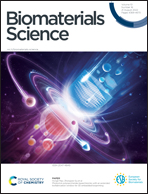BSA-templated ultrasmall Ag/Gd2O3 as a self-enabled nanotheranostic for MR/CT/PA tri-modality imaging and photothermal therapy†
Abstract
It is becoming more and more important to effectively integrate multiple complementary diagnostic imaging and synergistic therapies into a nano-platform, but it is still challenging. Here, we used bovine serum albumin (BSA) as a template to prepare ultra-small Ag/Gd2O3 (Ag/Gd@BSA) hybrid nanoparticles with high water dispersion by a biomineralization strategy for magnetic resonance (MR)/computed tomography (CT)/photoacoustic (PA) imaging-guided photothermal therapy (PTT). Compared with commercial MR and CT contrast agents, we showed that these well-characterized BSA-templated nanotheranostics possessed higher r1 relaxivity (5.84 mM−1 s−1) and HU values. In addition, these nanotheranostics have an excellent NIR absorption feature and outstanding photothermal conversion efficiency (47.4%) in the solution phase. The in vivo imaging experiment demonstrated that the Ag/Gd@BSA hybrid nanoparticles could serve as tri-modality imaging contrast agents to enable precise diagnosis of tumors. Meanwhile, it was also revealed that Ag/Gd@BSA had ability to be an ideal nanotherapeutic agent to achieve a satisfactory tumor treatment effect through PTT. Also, we showed the good biocompatibility of Ag/Gd@BSA nanoparticles. Overall, these results indicated that Ag/Gd@BSA was an effective nanotheranostic, which could accurately identify tumor sites and realize complete tumor elimination, having great potential in clinical transformation.



 Please wait while we load your content...
Please wait while we load your content...